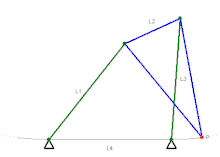Straight line mechanism
In the late seventeenth century, before the development of the planer and the milling machine, it was extremely difficult to machine straight, flat surfaces. For this reason, good prismatic pairs without backlash were not easy to make. During that era, much thought was given to the problem of attaining a straight-line motion as a part of the coupler curve of a linkage having only revolute connection. Probably the best-known result of this search is the straight line mechanism development by Watt for guiding the piston of early steam engines. Although it does not generate an exact straight line, a good approximation is achieved over a considerable distance of travel.



bars of identical colour are of equal length

Nearly straight line linkages
- Watt's linkage (1784)
- Chebyshev linkage
- Chebyshev's Lambda Mechanism (1878) (Can trade off straightness and near constant velocity)
- Hoeckens linkage (1926)
- Roberts Mechanism
Perfect straight line linkages
Eventually, several linkages were discovered that produced perfect linear output:
- Scott Russell linkage
- Sarrus linkage (1853)
- Peaucellier–Lipkin linkage (1864)
- Hart's inversor/Hart's A-frame (1874)
- Quadruplanar-Inversor (1875)
Rotary straight line mechanisms
- Cardan straight line mechanism[1]
- Tusi couple (1247) hypocycloid straight-line mechanism
- Trammel of Archimedes
Sources
- https://web.archive.org/web/20180418124753/http://kmoddl.library.cornell.edu/model.php?m=139 Reuleaux Collection, Cornell university
- Theory of Machines and Mechanisms, Joseph Edward Shigley
External links
- Cornell university (archived) - Straight-line mechanism models
- Alfred Kempe (1877). How to Draw a Straight Line (PDF). Macmillan – via University of California at Irvine.
- Daina Taimina. "How to Draw a Straight Line - a tutorial". Cornell University.
- Simulations using the Molecular Workbench software
- bham.ac.uk - Hart's A-frame (draggable animation) 6-bar linkage